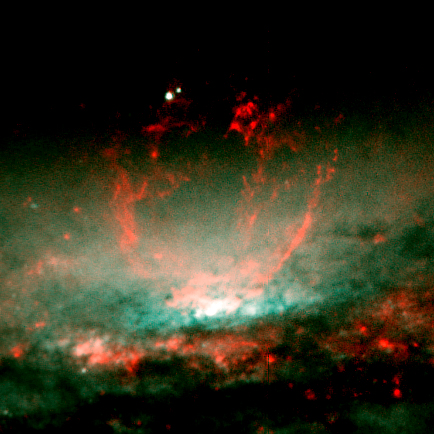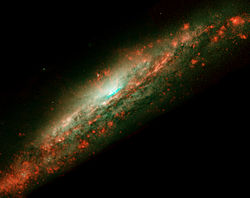NGC 3079 (captured by the Hubble Space Telescope)
Autor/Urheber:
NASA/ESA, Gerald Cecil (University of North Carolina), Sylvain Veilleux (University of Maryland), Joss Bland-Hawthorn (Anglo-Australian Observatory), and Alex Filippenko (University of California at Berkeley)
Shortlink:
Quelle:
Größe:
434 x 434 Pixel (198344 Bytes)
Beschreibung:
This NASA/ESA Hubble Space Telescope image shows the lumpy bubble of hot gas located at the center of the NGC 3079 galaxy's disk. Astronomers suspect that the bubble is being blown by "winds" (high-speed streams of particles) released during a burst of star formation. Gaseous filaments at the top of the bubble are whirling around in a vortex and are being expelled into space. Eventually, this gas will rain down upon the galaxy's disk where it may collide with gas clouds, compress them, and form a new generation of stars. The two white dots just above the bubble are probably stars in the galaxy.
Kommentar zur Lizenz:
| This file is in the public domain because it was created by NASA and ESA. NASA Hubble material (and ESA Hubble material prior to 2009) is copyright-free and may be freely used as in the public domain without fee, on the condition that only NASA, STScI, and/or ESA is credited as the source of the material. This license does not apply if ESA material created after 2008 or source material from other organizations is in use. The material was created for NASA by Space Telescope Science Institute under Contract NAS5-26555, or for ESA by the Hubble European Space Agency Information Centre. Copyright statement at hubblesite.org or 2008 copyright statement at spacetelescope.org. For material created by the European Space Agency on the spacetelescope.org site since 2009, use the {{ESA-Hubble}} tag. |
Lizenz:
Public domain
Relevante Bilder
Relevante Artikel
NGC 3079NGC 3079 ist eine Balken-Spiralgalaxie mit aktivem Galaxienkern vom Hubble-Typ E3 im Sternbild Großer Bär am Nordsternhimmel. Sie ist schätzungsweise 53 Millionen Lichtjahre von der Milchstraße entfernt und hat einen Durchmesser von etwa 125.000 Lichtjahren. .. weiterlesen


